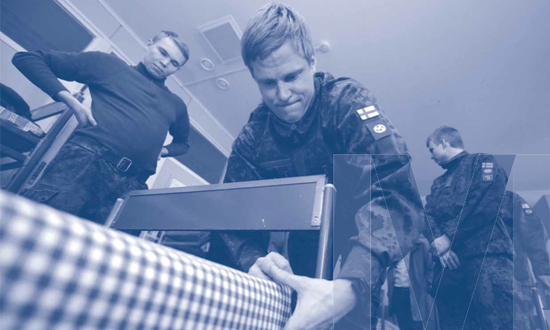The argument that the security environment has improved can be dismissed with equanimity – at least in Eastern Europe, this has ceased to be the case ever since the Russia-Georgia War (or in fact, already since President Vladimir Putin rose to power and the beginning of the second war in Chechnya in 1999). The main reason for reduction of armed forces in Europe is a very prosaic one – it is due to cutbacks in defence spending. The economic crisis and, following close on its heels, the euro debt crisis have in the last five years made these processes resemble a unilateral disarmament.
If smaller yet more efficient armed forces are even to be considered, they would have to be thoroughly modernized, and that means procuring a large amount of new weaponry and equipment and investing in battle training. Real and substantive modernization of the armed forces would thus require defence spending to be temporarily increased, not decreased.
Here we have an obvious contradiction: smaller armed forces cannot possibly be more efficient in conditions where defence spending is reduced. They will simply be weaker and less capable for battle.
Finland has been one of the few European countries that has been an exception to the current trend of defence spending cuts and armed forces reductions. Unfortunately the axe is now catching up with Estonia’s northern neighbours.
The political decisions for cutting back defence spending have already been made. Finland’s military spending will decrease gradually from the 2.45 billion euros in 2011 to about 2.2 billion euros in 2015. Over four years, it is planned to cut the budget by 575 million euros (for purposes of comparison: Estonia’s defence spending in 2013 is close to 380 million euros). Naturally the importance of defence spending in Finnish GDP will decrease significantly.
Lively public debate has taken place regarding the consequences of defence spending cuts and the debate will certainly continue. It has mainly focused on two issues – which units will be disbanded and which will be retained; and what will happen to the close to 2,200 professional troops who will have to leave active service.
These topics – undoubtedly politically important ones – are secondary from the point of view of the fighting capability of Finland’s wartime defence forces. The key question is in fact the planned reduction of the wartime defence forces from 350,000 to 230,000 and the scrapping of the defence districts.
During the Cold War, the Finnish wartime defence forces numbered around 550,000. It was difficult to arm and equip such a large wartime defence force at the relatively modest levels of defence spending (an average of 1.3-1.4% of GDP per year) but they made do. After the fall of the Soviet Union, it was logical and justified that the Finnish defence forces be downsized, but the Putin-era foreign policy, military doctrine and the rise in Russian defence spending and modernization of the armed forces that have characterized this decade fail to provide a rationale for further cutbacks.
Finland’s territory is so large that our northern neighbours should not cut their armed forces troop levels below 270,000 to 280,000 men. If the cuts are implemented in full, this could mean the end of Finland’s independent defensive capability in the traditional sense. In such a case, Finland (like Estonia) would have only a primary independent defensive capability and Finland would need foreign assistance in case of a military conflict. Finland could find itself in a situation where the question of whether or not to enter NATO is a moot point, as our northern neighbours would be forced to do so out of a sheer critical defensive need.
The abandonment of the defence districts is also a very fundamental decision. This is a dangerous mistake. Why was this error committed and what consequences will it have? The decision is a continuation of a previous error – creating an army staff in the previous decade. Finland has always been able to function without an army staff, even in World War II, as the general staff has fulfilled this role. I don’t claim that Estonia has done any better – after all, we have made the same mistake. The army staff in both countries is a pointless intermediate link that is redundant with the general staff. If the reduction of the numbers of command levels was seen as a measure to increase thrift, the army staff should have been disbanded – not the defence districts.
Finnish NHL ice hockey player Mikko Koivu, captain of the Minnesota Wild, learns how to make a military-style bed, after signing up as a private in the Finnish Army, at the Lahti sports school, in Lahti, Finland, Tuesday April 19, 2011. Finland has mandatory military service for men, with a minimum duration of six months. Photo: Scanpix
Does the Finnish army staff intend to lead brigade-sized manoeuvring units centrally? Even after reductions, there will be too many of them, and Finland’s territory is far too large to be able to lead them in an efficient manner. Where will the command level be in future, and where will the command over manoeuvre units and local protection (guerrilla etc) units in a certain area – the basis for territorial defence – be consolidated? There is no longer such a command level.
I understand that from time to time in Estonia, people will come out with some bit of foolishness related to the national defence, because for a long time, military thinking lacked continuity, and the military culture that has amassed over the last 20 years is not all that deep. But our northern neighbours should not have similar problems. No matter how dire the situation with resources, they shouldn’t start their makeover by demolishing a command structure that has worked for decades. For a small country, every step toward excessive centralization of the military command system means, inevitably, a small step toward self-transformation into the ideal adversary from the perspective of a larger country.
Is smaller more effective or efficient, then? There is no reason to think so, and I don’t think Finnish defence forces officers would support such a conclusion, either.
________________________________________________________________________________________________________________The Finnish Defence Force is dedicated to preserving Finland’s wartime history. The Military Museum in Helsinki has exhibitions in Kruununhaka and on the island fortress Suomenlinna.The organisation endorses also ten branch military museums:• Forum Marinum Linnankatu 72, Turku• AntiAircraft Museum (Ilmatorjuntamuseo) Klaavolantie 2, Tuusula• The Infantry Museum (Jalkaväkimuseo) Jääkärinkatu 6-8, Mikkeli• Finnish Air Force Museum (Keski-Suomen Ilmailumuseo) Tikkakoskentie 125, Tikkakoski• Mobilia, the automobile and road museum, Kustaa Kolmannen tie 75, Kangasala• The Tank Museum (Panssarimuseo) Hattulantie 334, Parolannummi• Salpa Centre / Engineer Museum (Pioneerimuseo) Keskustie 4, Miehikkälä• Museum of Military Medicine (Sotilaslääketieteen museo) Helsingintie 199, Lahti• Finland’s Artillery Museum (Suomen Tykistömuseo) Linnankasarmi, Hämeenlinna• The National Signals Museum (Viestimuseo) Varuskunta, Viestimuseontie rak. 64, Riihimäki
Leo Kunnas is reserve lieutenant colonel and writer / Photo: Delfi, Ilmar Saabas







